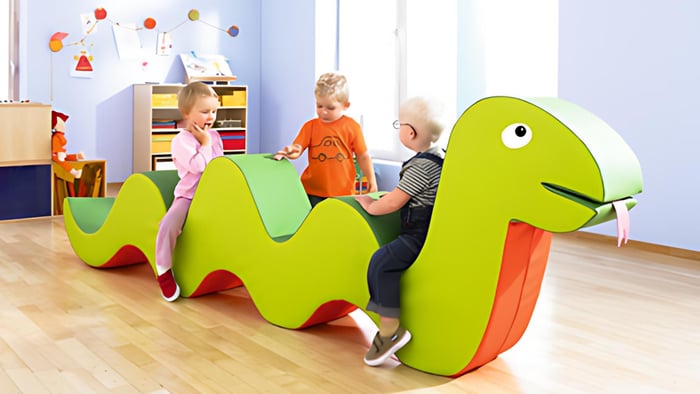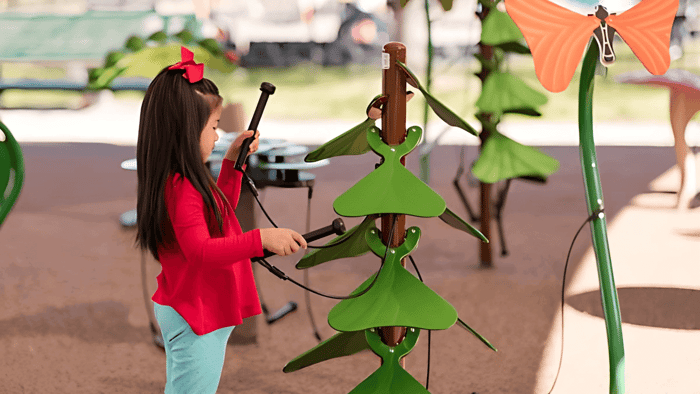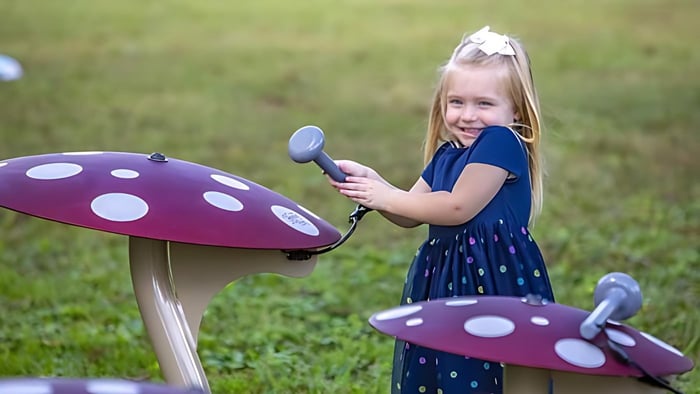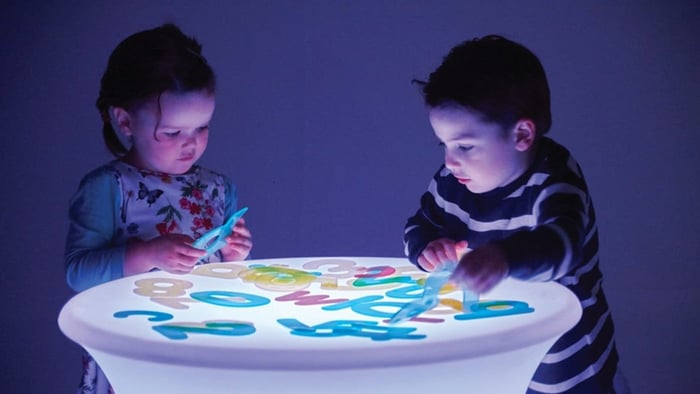
LED Activity Tables vs Building Blocks for Learning Play
Table of Contents
- Choosing between LED activity tables and traditional building blocks for your preschooler? Research reveals surprising differences in how each tool develops crucial skills—and one combination method delivers unexpected learning benefits that most parents never consider.
- Studies Show Both Tools Drive Different Developmental Gains
- LED Tables Excel at Sensory Integration and Visual Skills
- Building Blocks Build Foundation for STEM Success
- Age-Specific Benefits Reveal Optimal Usage Windows
- Classroom Integration Strategies That Work
- Summary Comparison
- Choose Both for Balanced Whole-Child Development
- FAQs
Choosing between LED activity tables and traditional building blocks for your preschooler? Research reveals surprising differences in how each tool develops crucial skills—and one combination method delivers unexpected learning benefits that most parents never consider.
Key Takeaways:
- LED activity tables excel in sensory integration and visual discrimination while building blocks develop spatial reasoning and motor skills that support STEM learning
- Preschoolers aged 3-5 gain the most from LED tables for sensory processing, while building blocks benefit children from 18 months to 7 years for spatial reasoning and fine motor development
- Combining translucent blocks on LED surfaces creates powerful learning experiences that merge both developmental benefits
- Studies show children who engaged in block play between ages 3-5 performed better in elementary math classes
- Both tools serve different learning styles and should be integrated together for balanced whole-child development
When choosing learning tools for preschool classrooms, educators often find themselves weighing the benefits of modern LED activity tables against traditional building blocks. Both offer powerful developmental advantages, but understanding their unique strengths helps create more effective learning environments tailored to diverse student needs.
Studies Show Both Tools Drive Different Developmental Gains
Scientific evidence demonstrates that LED activity tables and building blocks target distinct areas of child development. Longitudinal studies reveal that children who engaged in block play between ages three and five performed significantly better in elementary math classes. This research establishes building blocks as foundational tools for academic success.
Meanwhile, studies in sensory integration therapy found that light tables significantly improved social skills and sensory processing in children with autism. Additional research showed that light table interventions substantially enhanced visual-motor integration and visual perception in children with developmental disabilities.
The evidence points to complementary rather than competing benefits. Building blocks demonstrate robust, long-term cognitive gains with established links to STEM achievement, while LED tables excel at engagement, sensory processing, and inclusive learning experiences that support diverse learning needs.
Whitney Plus Radiant LED Light Table
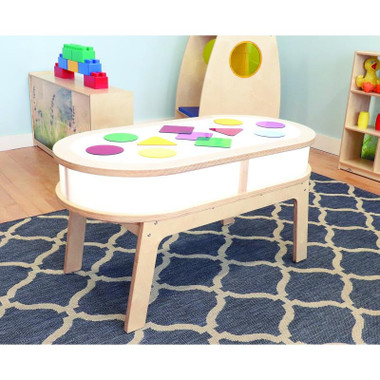
$1389.98
Not all light tables are created equal! Our Radiant LED Light Table stands out with its elegant curved design, unique side light panel, and exceptionally...… read more
LED Tables Excel at Sensory Integration and Visual Skills
LED activity tables create unique learning environments that capitalize on children's natural attraction to light and color. These illuminated surfaces transform ordinary materials into engaging learning experiences that hold attention longer than traditional table activities.
1. Enhanced Visual Discrimination and Pattern Recognition
The backlit surface of LED tables dramatically improves children's ability to detect subtle differences in colors, patterns, and shapes. Translucent materials become more vivid and detailed when illuminated from below, allowing preschoolers to observe transparency, opacity, and color mixing in ways impossible on regular surfaces. This enhanced visual input strengthens pre-literacy skills as children learn to distinguish between similar letters and develop pattern recognition abilities essential for reading readiness. High-quality LED tables provide consistent, even lighting that supports these critical visual development milestones.
2. Sensory Processing Support for Special Needs Children
LED tables offer therapeutic benefits for children with sensory processing differences or autism spectrum disorders. The gentle, consistent light can soothe children sensitive to harsh fluorescent classroom lighting while providing controlled sensory input. Studies indicate that managing sensory inputs in multi-sensory environments increases attention and reduces repetitive behaviors in autistic children aged 4-12 years. Educators report that light tables help sensory-seeking children focus their need for stimulation in productive ways while offering calming experiences for those who become overwhelmed by typical classroom environments.
3. Collaborative Play and Communication Development
The shared surface of LED tables naturally encourages cooperative activities and conversation. Children gather around the illuminated workspace, pointing out discoveries, sharing materials, and building on each other's ideas. This collaborative dynamic fosters communication skills, turn-taking, and social negotiation in organic ways. The engaging nature of light play draws children together, creating opportunities for peer interaction that might not occur with individual manipulatives.
Building Blocks Build Foundation for STEM Success
Traditional building blocks remain one of the most researched and validated learning tools in early childhood education. Their impact extends far beyond simple construction play, establishing neural pathways crucial for mathematical thinking and spatial reasoning.
1. Spatial Reasoning Skills Directly Link to Math Achievement
Block play develops spatial awareness as children manipulate three-dimensional objects and learn positional vocabulary like "under," "over," and "inside." This spatial understanding forms the foundation for geometry, measurement, and problem-solving skills that emerge in elementary mathematics. Children who engage regularly in block construction demonstrate stronger performance on standardized math assessments years later, indicating the lasting impact of early spatial skill development.
2. Fine Motor Control and Hand-Eye Coordination
Building tall towers and precise structures requires children to develop sophisticated motor planning and execution skills. Each block placement demands careful consideration of balance, weight distribution, and structural stability. This process strengthens hand-eye coordination, bilateral coordination, and the refined motor control necessary for writing and detailed artwork. The graduated challenge of increasingly complex builds naturally scaffolds motor skill development from simple stacking to elaborate architectural creations.
3. Problem-Solving Through Construction Challenges
Block building presents continuous problem-solving opportunities as children encounter structural failures and design challenges. When towers topple or bridges collapse, children must analyze what went wrong and devise alternative approaches. This trial-and-error learning develops persistence, analytical thinking, and creative problem-solving strategies. The immediate physical feedback helps children understand cause-and-effect relationships while building confidence in their ability to overcome obstacles through experimentation.
Age-Specific Benefits Reveal Optimal Usage Windows
Understanding developmental timing helps educators maximize the impact of both learning tools by matching activities to children's emerging capabilities and interests.
Rainbow Blocks - 30 pc. set
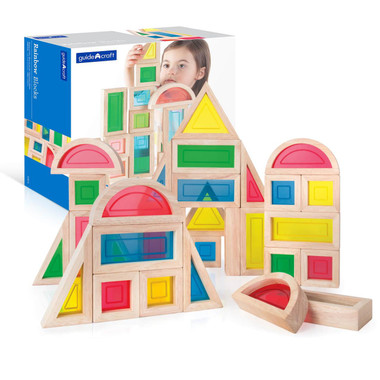
$99.95
Rainbow Blocks offer a vibrant journey into the world of color and light! Ignite your child's curiosity by mixing blocks to create stunning new hues,...… read more
LED Tables Boost Sensory Integration and Visual Perception in 3-5 Year Olds
Preschoolers between ages 3-5 show the most dramatic gains from LED table activities. During this period, visual discrimination skills are rapidly developing, making children especially responsive to the enhanced contrast and detail provided by backlighting. The multisensory input supports focus and activities during a stage when attention spans are still developing. Children with sensory processing needs often show even greater advances, as the controlled sensory environment helps regulate their nervous systems while engaging their curiosity.
Building Blocks Develop Fine Motor Skills and Spatial Reasoning Across 18 Months-7 Years
Building blocks offer benefits across a broader age range than LED tables. Toddlers as young as 18 months gain manual dexterity and early spatial awareness through simple stacking activities. The peak learning window extends through early elementary years, with 4-7 year olds showing the most robust advances in spatial ability, mathematical thinking, and creative problem-solving. This extended developmental window makes blocks particularly valuable for mixed-age classrooms and programs serving children across multiple years.
Classroom Integration Strategies That Work
Successful implementation requires thoughtful planning that considers space, materials, and learning objectives while accommodating diverse student needs and interests.
1. Combine Both Tools for Maximum Learning Impact
Rather than viewing LED tables and building blocks as competing options, effective early childhood programs integrate both tools strategically. Rotation schedules can ensure all children experience both types of play, while simultaneous availability allows children to choose based on their current interests and learning style preferences. This approach recognizes that some children thrive with the sensory engagement of light tables while others prefer the tactile construction challenges of blocks.
2. Use Translucent Blocks on LED Tables for Color and STEM Activities
Combining translucent building blocks with LED surfaces creates powerful hybrid learning experiences. Children can study color mixing by layering translucent blocks, observe how different materials interact with light, and build structures that glow from within. This integration merges the spatial reasoning benefits of construction with the visual discrimination advantages of backlighting. Pattern blocks, translucent geometric shapes, and colored acrylic materials work particularly well for these combined activities.
3. Match Tools to Individual Learning Styles
Effective teachers observe how individual children engage with different materials and adjust offerings accordingly. Children who are visual learners may enjoy the dramatic effects possible with LED tables, while kinesthetic learners may prefer the physical manipulation of building blocks. Children with sensory processing differences may need specific accommodations—some benefit from the calming effects of light tables, while others find the tactile feedback of blocks more regulating. Flexible programming allows children to access the tools that best support their learning needs.
Summary Comparison
| Developmental Domain | LED Light Tables | Building Blocks |
|---|---|---|
| Sensory Processing | Strong, especially visual and tactile | Moderate |
| Fine Motor Skills | Strong (small piece manipulation) | Strong (stacking, balancing) |
| Visual Discrimination | Strong (color, pattern, detail) | Moderate |
| Spatial Reasoning | Moderate (shape, symmetry) | Strong (3D spatial concepts) |
| Cognitive Skills | Pattern recognition, problem-solving, STEM concepts | Problem-solving, executive function, creativity |
| Social-Emotional | Collaboration and communication | Cooperation, negotiation, emotional skills |
| Language/Literacy | Early literacy skills, storytelling | Vocabulary, narrative skills |
| Creativity | Artistic expression, color mixing | Construction, imaginative play |
| Attention & Focus | Increased sustained attention | Varies by activity |
Choose Both for Balanced Whole-Child Development
The question isn't whether LED activity tables or building blocks are superior—both serve essential roles in quality early childhood programming. LED tables excel at sensory integration, visual perception, and collaborative creativity, while building blocks provide unmatched spatial reasoning, motor skill development, and STEM readiness. The most effective approach combines both tools strategically, allowing children to benefit from their complementary strengths while accommodating diverse learning styles and developmental needs. Programs that offer both options create richer, more inclusive learning environments where every child can thrive.
For educators seeking high-quality LED activity tables, Little People's Cove specializes in durable, child-safe lighting solutions designed specifically for early learning environments.
FAQs
What specific developmental skills are improved by each?
LED light tables primarily improve sensory integration, visual discrimination, fine motor skills, creativity, and social collaboration by engaging children with light, color, and tactile materials. They support early literacy, math concepts, and sustained attention. Building blocks, in contrast, significantly develop fine motor coordination, spatial reasoning, problem-solving, cognitive skills, social-emotional abilities, and language through construction and imaginative play. While both enhance creativity and cooperation, light tables focus more on sensory and visual engagement, and blocks on spatial and motor development. Together, they complement each other in fostering balanced early childhood growth.
Which is better for group or individual play?
LED light tables are generally better suited for group play because their illuminated surface naturally encourages shared exploration, collaboration, and communication among children as they discover colors, shapes, and patterns together. They create a focal point that attracts multiple children to gather, facilitating cooperative learning and turn-taking in a tactile and visual context.
Building blocks, on the other hand, are flexible for both individual and group play. Children can build independently to develop fine motor and spatial skills or work in small groups for collaborative construction and imaginative play that fosters social-emotional skills like negotiation and teamwork. Block play can easily accommodate varied play styles and group sizes depending on the setting.
Which ages benefit most how does each tool support children with sensory processing differences?
Children from about 18 months to 6 years benefit most from LED light tables and building blocks, each supporting different developmental needs. LED tables are especially helpful for children with sensory processing differences, offering a soothing, consistent light that promotes focus, sensory integration, fine motor skills through manipulating translucent materials, visual discrimination, and sustained attention. Building blocks support children with fine motor delays by strengthening hand-eye coordination and motor planning through stacking and balancing. They also aid language development by enhancing vocabulary, narrative skills, and social communication during cooperative play. Both tools provide adaptable, play-based learning to meet varied developmental challenges.

